9-3 Plate movement produces earthquakes, mountain ranges, and volcanoes that shape Earth’s surface
Evidence from the bottom of the ocean confirmed the theory of moving continents
One of the most important geological discoveries of the twentieth century was the realization that Earth’s crust is constantly changing. We have learned that the crust (which includes ocean seafloors) is divided into huge plates whose motions produce earthquakes, volcanoes, mountain ranges, and oceanic trenches. Furthermore, material in these plates is slowly but constantly replenished about every few hundred million years, so that most of Earth’s surface is young compared to the planet’s 4.54 billion year age. The motion of Earth’s plates has come to be the central unifying theory of geology, much as the theory of evolution has become the centerpiece of modern biology. By understanding the effects of plate motion and what causes it, we also learn how to read the surface of other planets and moons to learn about their interiors.
Continental Drift
Anyone who carefully examines a map of Earth might come up with the idea of moving continents. South America, for example, would fit snugly against Africa were it not for the Atlantic Ocean. As Figure 9-11 shows, the fit between landmasses on either side of the Atlantic Ocean is quite remarkable. This observation inspired the German meteorologist Alfred Wegener to find evidence for “continental drift”—the idea that the continents on either side of the Atlantic Ocean have simply drifted apart. After much research, in 1915 Wegener published the theory that there had originally been a single gigantic supercontinent, which he called Pangaea (meaning “all lands”), that began to break up and drift apart roughly 200 million years ago. Other geologists refined this theory over time, arguing that Pangaea must have split up in stages to make the continents we see today (Figure 9-12). (Note: No humans were present to witness the break-up; the earliest humans did not appear on Earth until about 2 million years ago. At the time that Pangaea broke up, small dinosaurs were the dominant land animals.)
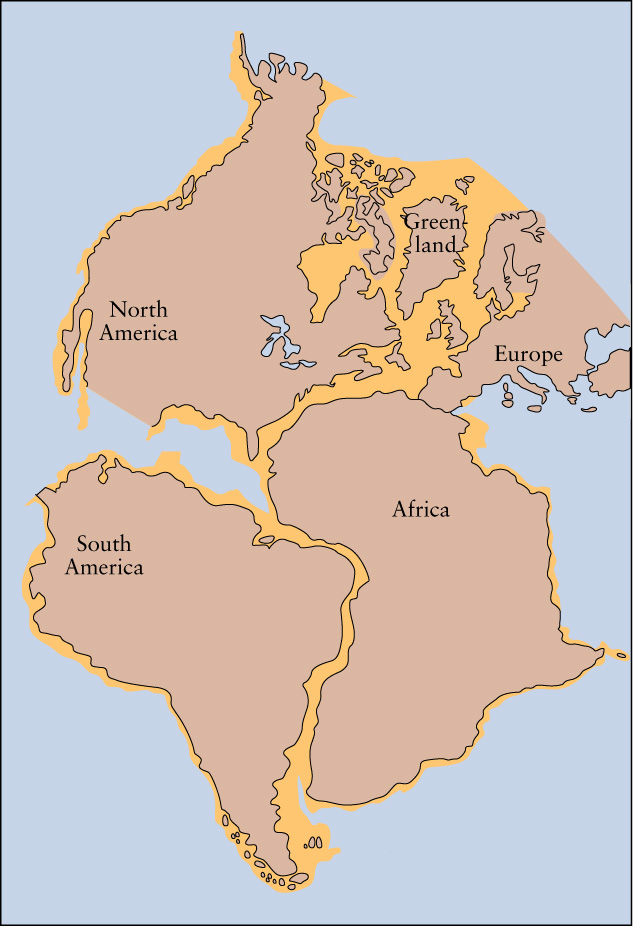

Sadly, most geologists ridiculed Wegener’s ideas and he died before they were accepted. Although it was generally accepted that the continents do “float” on the denser, somewhat plastic mantle beneath them, few geologists could accept the idea that entire continents could move around Earth at speeds as great as several centimeters per year. The “continental drifters” could not explain what forces could move the massive continents around.
Plate Tectonics
Beginning in the mid-1950s, however, geologists found evidence that material is being forced upward to the crust from deep within Earth. Completely submerged mountain ranges on the ocean floors were discovered, including the Mid-Atlantic Ridge, which is the longest mountain chain in the world and stretches all the way from Iceland to Antarctica (Figure 9-13). Through further analysis, it was found that rock from Earth’s mantle is being melted and then forced upward along the Mid-Atlantic Ridge, which is in essence a long chain of underwater volcanoes that forms new seafloor.
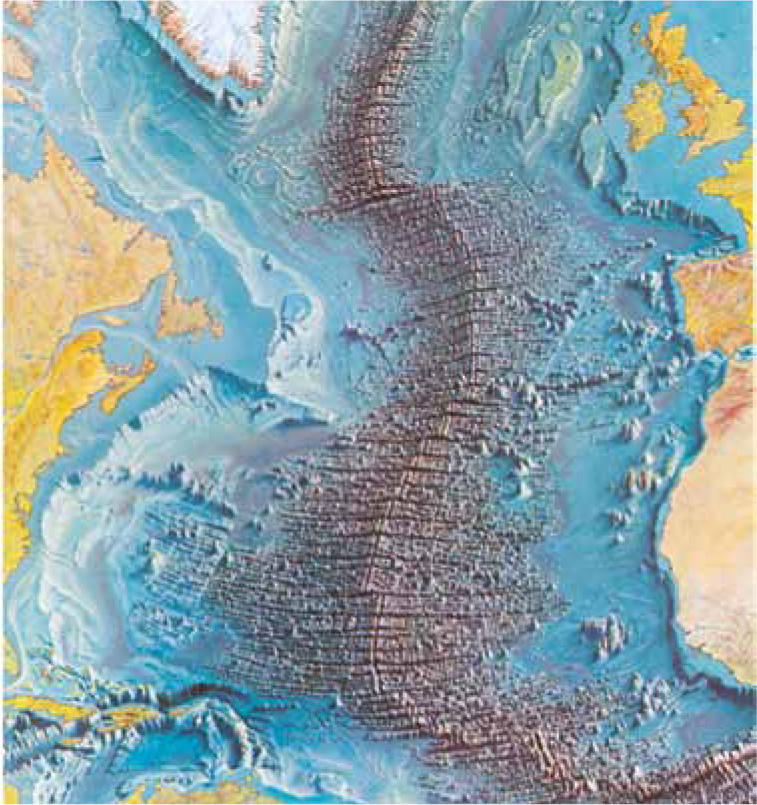
As newly risen material cools and hardens at the underwater ridge, this new seafloor material also moves away from the ridge, causing seafloor spreading. For example, because of seafloor spreading from the Mid-Atlantic Ridge, South America and Africa are moving apart at a speed of roughly 3 cm per year, with new seafloor forming in between. Working backward, these two continents would have been next to each other some 200 million years ago—just as Wegener suggested (see Figure 9-11).
In the early 1960s, geologists began to find additional evidence supporting the existence of large, moving plates. Thus was born the modern theory of crustal motion, which came to be known as plate tectonics (from the Greek tekton, meaning “builder”).
Geologists today realize that earthquakes and volcanoes tend to occur at the boundaries of Earth’s tectonic plates, where the plates are colliding, separating, or sliding against each other. The boundaries of the plates therefore stand out clearly when the epicenters of earthquakes are plotted on a map, as in Figure 9-14. The boundary in Figure 9-14 that surrounds the Pacific plate is called the Ring of Fire: More than 75% of the world’s volcanoes are found here, along with 90% of the world’s earthquakes.
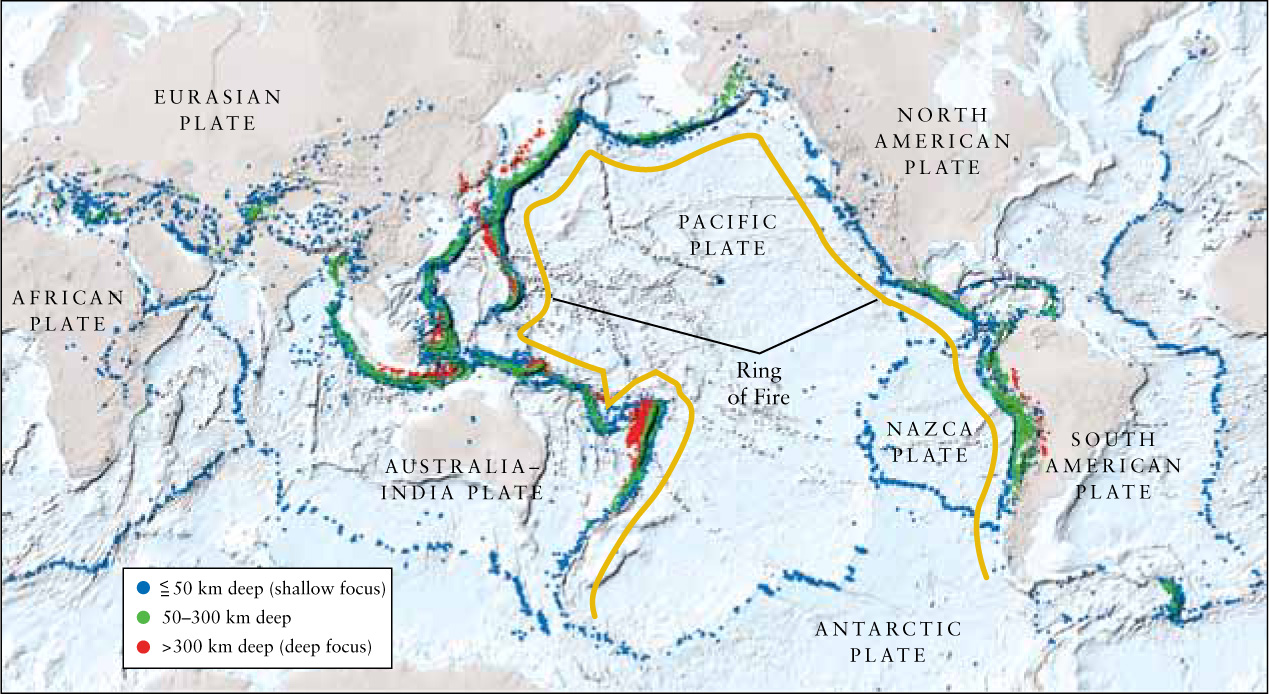
 Earth’s Major Plates The boundaries of Earth’s major plates are the scenes of violent seismic and geologic activity. Most earthquakes occur where plates separate, collide, or rub together. Plate boundaries are therefore easily identified simply by plotting earthquake epicenters (shown here as dots) on a map. The colors of the dots indicate the depths at which the earthquakes originate. Typical speeds of plates are between 2 cm and 10 cm per year, where some separate from each other and some move closer together.
Earth’s Major Plates The boundaries of Earth’s major plates are the scenes of violent seismic and geologic activity. Most earthquakes occur where plates separate, collide, or rub together. Plate boundaries are therefore easily identified simply by plotting earthquake epicenters (shown here as dots) on a map. The colors of the dots indicate the depths at which the earthquakes originate. Typical speeds of plates are between 2 cm and 10 cm per year, where some separate from each other and some move closer together.
Convection and Plate Motion
What makes the plates move? The answer is twofold. First, heat flows outward from Earth’s hot interior to its cool crust, and second, this heat flows by convection. In Earth’s convection, hotter interior temperatures cause rocky material to expand, lowering the material’s density compared to its surroundings, which then causes it to rise. This material then cools off at or near the surface, increasing the material’s density compared to its surroundings, which then causes it to sink. Figure 9-5 shows that convection can cause material to circulate in convection currents. While convection occurs at many layers within the mantle, it is the convection of Earth’s outer layer that directly reshapes our planet’s surface. This outer layer is called the lithosphere (from the Greek word litho for “rock”), which is physically divided into the plates described by plate tectonics. The lithosphere is a cooled rocky outer layer that contains the seafloor in the oceans, and the crust that forms continents.
Figure 9-15 shows the basic features of an oceanic seafloor plate. Hot, molten subsurface rock seeps upward along oceanic rifts, hardening to form the seafloor plates. (The Mid-Atlantic Ridge, shown in Figure 9-13, is an oceanic rift.) Where a seafloor plate meets a continental plate (on the right in Figure 9-15), the higher-density seafloor plate sinks back down into the mantle, creating a subduction zone. In most cases, the greatest force that moves seafloor plates comes from slab pull at the sinking edge of the plate: Due to gravity, the cooler high-density seafloor slab falls into the warmer lower-density mantle.
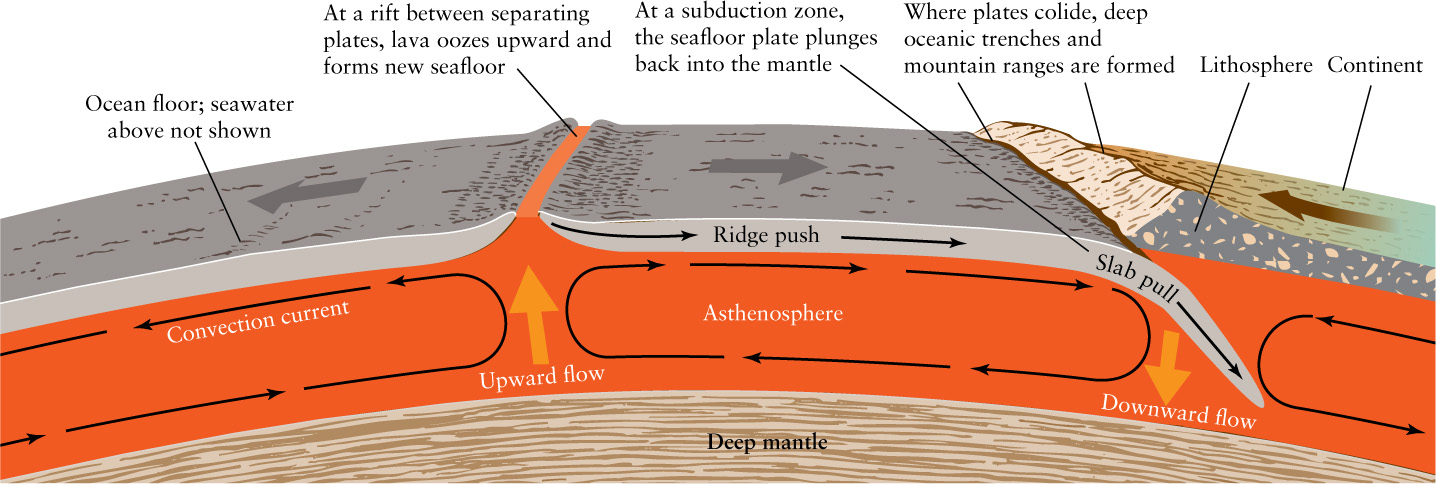
 The Mechanism of Plate Tectonics Convection currents transport rock to a rift where it oozes toward the surface as magma, hardens in the cold ocean, and spreads away from the rift to create new seafloor. Each side of the rift exhibits seafloor spreading and is a separate tectonic plate. When higher-density seafloor meets lower-density continental crust at a subduction zone, the seafloor plunges downward. Slab pull, due to gravity on this slab, is the dominant force moving the plate across Earth. Collision of plates at a subduction zone also leads to mountain-building, earthquakes, and volcanoes.
The Mechanism of Plate Tectonics Convection currents transport rock to a rift where it oozes toward the surface as magma, hardens in the cold ocean, and spreads away from the rift to create new seafloor. Each side of the rift exhibits seafloor spreading and is a separate tectonic plate. When higher-density seafloor meets lower-density continental crust at a subduction zone, the seafloor plunges downward. Slab pull, due to gravity on this slab, is the dominant force moving the plate across Earth. Collision of plates at a subduction zone also leads to mountain-building, earthquakes, and volcanoes.
Another force on the oceanic plate is ridge push, where molten rock emerging from the oceanic rift is pulled down the ridge’s slopes by gravity, just as a ball rolls down a hill. Thus, gravity gives a push to the plate, contributing to its horizontal slide. With mountainous ridges typically a couple of miles high, this can be a large force.
CAUTION!
The plates are not merely riding on top of deeper convection currents. Sometimes convection in lower layers drags the plates along, and other times the plates drag lower layers along, but both of these cases tend to create weaker forces than slab pull and ridge push. While convection currents also circulate deeper in the mantle, plate tectonics results from convection at Earth’s surface. A further caution is that rocky material only becomes liquid (or magma) very near the surface at the rifts; most of the convection current is very slow plastic flow within mantle rock that is under great forces, and this mantle rock would feel very solid to the touch.
A rift between two plates is not always found at the ocean seafloor, although continental rifts occur much less often than oceanic rifts. As shown in Figure 9-16, the valley created by a continental rift can be filled with adjacent seawater. If the continental spreading persists it can slowly transition into a mid-ocean rift, as happened between the continental plates spreading from Pangaea. However, continental plates are thicker and tend to convect more slowly than oceanic plates, and most continental plate motion comes from pushing by adjacent seafloor plates.
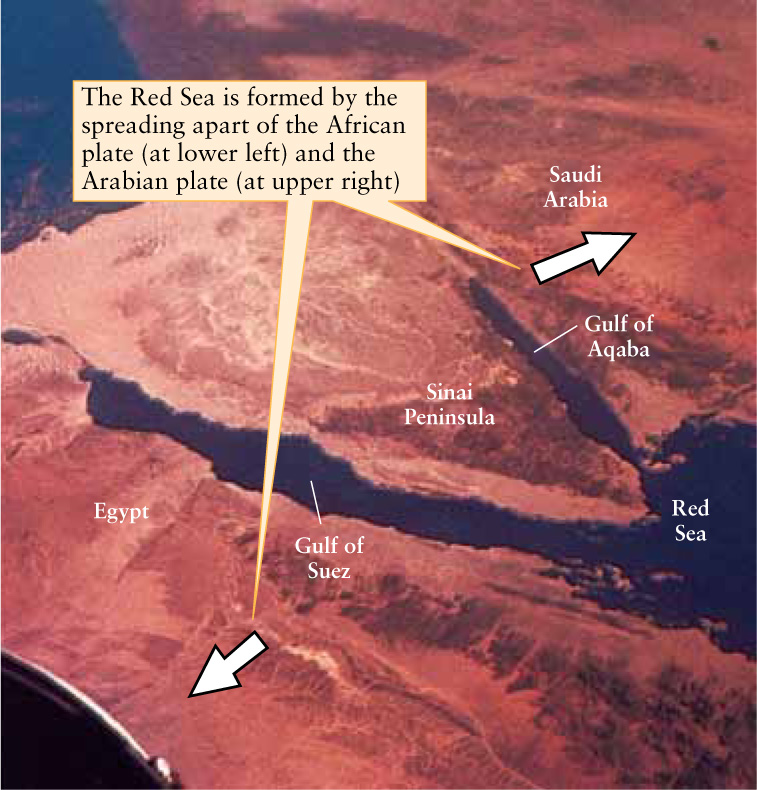
 The Separation of Two Plates The plates that carry Africa and Arabia are moving apart, leaving a great rift that has been flooded to form the Red Sea. This view from orbit shows the northern Red Sea, which splits into the Gulf of Suez and the Gulf of Aqaba.
The Separation of Two Plates The plates that carry Africa and Arabia are moving apart, leaving a great rift that has been flooded to form the Red Sea. This view from orbit shows the northern Red Sea, which splits into the Gulf of Suez and the Gulf of Aqaba.

 The boundaries between plates are the sites of some of the most impressive geological activity on our planet. Great mountain ranges, such as the Sierras and Cascades along the western coast of North America and the Andes along South America’s west coast, are thrust up by ongoing collisions between continental plates and the plates of the ocean floor. The Himalayas, due to the collision of plates containing India and China, contain the highest mountains on Earth (Figure 9-17).
The boundaries between plates are the sites of some of the most impressive geological activity on our planet. Great mountain ranges, such as the Sierras and Cascades along the western coast of North America and the Andes along South America’s west coast, are thrust up by ongoing collisions between continental plates and the plates of the ocean floor. The Himalayas, due to the collision of plates containing India and China, contain the highest mountains on Earth (Figure 9-17).
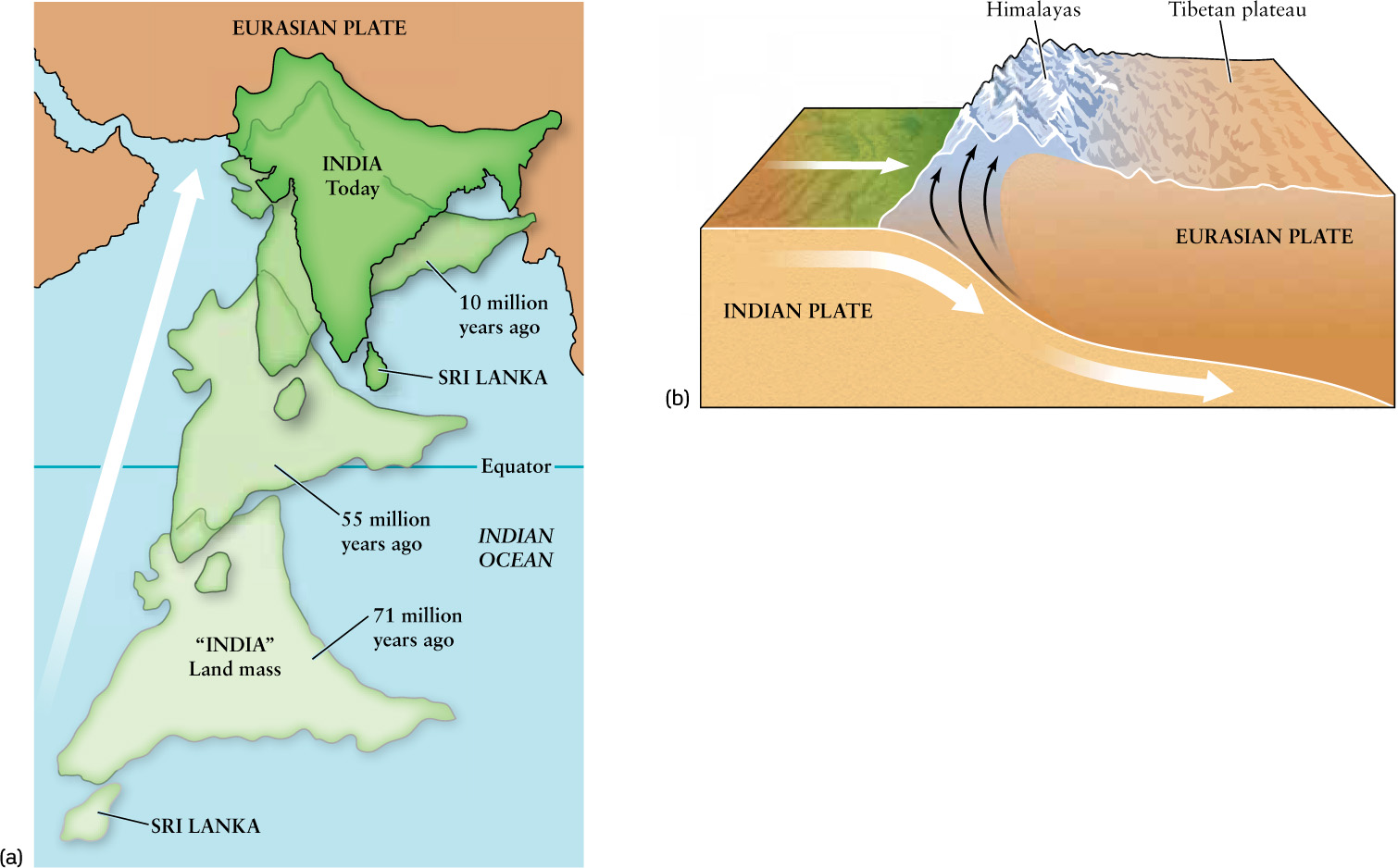
 The Collision of Two Plates Collisions between the plates that carry India and China have created Mount Everest and K2 in the Himalayas. (a) While plates typically move a few cm/yr, the Indian plate has sped along at up to 20 cm/yr. (b) Millions of years ago the ocean seafloor subducted neatly beneath the Eurasian plate, but now there is a buildup of crust on both plates that forms the Himalayas.
The Collision of Two Plates Collisions between the plates that carry India and China have created Mount Everest and K2 in the Himalayas. (a) While plates typically move a few cm/yr, the Indian plate has sped along at up to 20 cm/yr. (b) Millions of years ago the ocean seafloor subducted neatly beneath the Eurasian plate, but now there is a buildup of crust on both plates that forms the Himalayas.
CONCEPT CHECK 9-4
What are two forces that move tectonic seafloor plates?
The largest force is slab pull, as the dense sinking portion of the plate pulls on the entire seafloor plate. Another force is due to the portion of the plate on the side of the underwater mountains forming the midocean ridge. The weight of this portion of the plate pulls it down the ridge and pushes the entire plate; this force is called ridge push.
CALCULATION CHECK 9-1
If seafloor spreading opens South America and Africa apart at a speed of 2 cm per year, how long would it have taken for the Atlantic to open to a current width of 600 million (6 × 108) cm?
Using the relationship that distance equals rate times (6 × 108 cm) ÷ 2 cm/year = 3 × 108 years or 300 million years.
Plate Tectonics and the Varieties of Rocks
 Rocks are solid material made from minerals. A mineral can be made out of a single type of atom, such as diamond made from carbon, but most minerals contain molecules made from several different types of atoms. For example, quartz—which can form sandstone and sand at the beach and desert—is made from molecules of silicon and oxygen (SiO2). Plate tectonics play a major role in forming rocks and moving them around, as seen in the three major categories of rocks (Figure 9-18). Igneous rocks result when minerals cool from a molten state. (Molten rock is called magma when it is buried below the surface and lava when it flows out upon the surface, as in a volcanic eruption.) The ocean floor is made predominantly of a type of igneous rock called basalt (Figure 9-18a). Igneous rock is just what we expect for the spreading ocean seafloor, which is produced by material welling up from the mantle. Taken together, igneous rock in the seafloor and from volcanic flows on land comprise about 95% of Earth’s crust.
Rocks are solid material made from minerals. A mineral can be made out of a single type of atom, such as diamond made from carbon, but most minerals contain molecules made from several different types of atoms. For example, quartz—which can form sandstone and sand at the beach and desert—is made from molecules of silicon and oxygen (SiO2). Plate tectonics play a major role in forming rocks and moving them around, as seen in the three major categories of rocks (Figure 9-18). Igneous rocks result when minerals cool from a molten state. (Molten rock is called magma when it is buried below the surface and lava when it flows out upon the surface, as in a volcanic eruption.) The ocean floor is made predominantly of a type of igneous rock called basalt (Figure 9-18a). Igneous rock is just what we expect for the spreading ocean seafloor, which is produced by material welling up from the mantle. Taken together, igneous rock in the seafloor and from volcanic flows on land comprise about 95% of Earth’s crust.

Igneous, Sedimentary, and Metamorphic Rocks (a) Igneous rocks such as basalt are created when molten materials solidify. This example contains iron-rich minerals that give it its dark color. (b) Sedimentary rocks such as sandstone are typically formed when loose particles of soil or sand are fused into rock by the presence of other minerals, which act as a cement. (c) Metamorphic rocks are produced when igneous or sedimentary rocks are subjected to high temperatures and pressures deep within Earth’s crust. Marble is formed from sedimentary limestone; schist is formed from igneous rock.
Sedimentary rocks are produced by the accumulation of smaller particles. For example, winds and water can pile up layer upon layer of sand grains. Other minerals present amid the sand can gradually cement the grains together to produce sandstone (Figure 9-18b). In another process, the skeletal remains of tiny marine organisms can cover the ocean floor to form a sedimentary rock called limestone. The motion of tectonic plates can move such rocks to places far from where they were formed. This movement explains why the pyramids of Egypt are made of limestone that formed on the ocean floor. Plate tectonics can also upturn horizontally formed sedimentary rock, which explains the vertical layers of the hogback ridges in Colorado (see Figure 9-3).
Sometimes igneous or sedimentary rocks become buried far beneath the surface, where they are subjected to enormous pressure and high temperatures. These severe conditions can change the minerals and structure of the rocks, producing metamorphic rock (Figure 9-18c). The presence of metamorphic rocks at Earth’s surface tells us that tectonic activity sometimes lifts up material from deep within the crust. This activity can happen when two plates collide, as shown in Figure 9-17.
The Cycle of Supercontinents
Plate tectonic theory offers insight into geology on the largest of scales, that of an entire supercontinent. In recent years, geologists have uncovered evidence that points to a whole succession of supercontinents that once broke apart and then reassembled. Pangaea is only the most recent supercontinent in this cycle, which repeats about every 500 million years. As a result, intense episodes of mountain building have occurred at roughly 500-million-year intervals.
Apparently, a supercontinent sows the seeds of its own destruction because it blocks the flow of heat from Earth’s interior. In one scenario, as soon as a supercontinent forms, temperatures beneath it rise, much as they do when a lid is placed on a heated cooking pot. As heat accumulates, the lithosphere domes upward and cracks. Molten rock from the overheated asthenosphere wells up to fill the resulting fractures, which continue to widen as pieces of the fragmenting supercontinent move apart.
The changes wrought by plate tectonics are very slow on the scale of a human lifetime, but have occurred on Earth’s surface for more than 4 billion years. Ocean seafloor recycles back into the mantle every few hundred million years as continents are built up and broken apart. The lesson of plate tectonics is that the seemingly permanent face of Earth is in fact dynamic and ever-changing.
CONCEPT CHECK 9-5
What might cause a supercontinent to break apart?
In one scenario, a supercontinent traps heat beneath it, causing that region to expand and crack. This process allows fissures to be filled by rapidly upwelling material from underneath, breaking the continent apart.
CALCULATION CHECK 9-2
If supercontinents are formed and break up in a 500-million-year cycle, about how many supercontinents could come and go over Earth’s roughly 4.5-billion-year existence?
(5 × 109 years) ÷ (5 × 108 years/cycle) = 10 cycles.